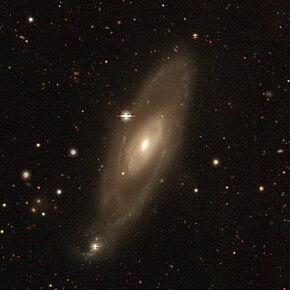NGC 1024
| NGC 1024 | |
|---|---|
 Legacy Surveys image of NGC 1024 | |
| Observation data (J2000 epoch) | |
| Constellation | Aries |
| Right ascension | 02h 39m 11s |
| Declination | +10° 50′ 48″ |
| Redshift | 0.011801 |
| Heliocentric radial velocity | 3,538 km/s |
| Distance | 159 Mly (48.7 Mpc) |
| Surface brightness | 23.61 mag/arcsec^2 |
| Other designations | |
| ARP 333, PGC 10048, MCG 2-7-20, UGC 2142, CGCG 439-22, IRAS 02365+1037 | |
NGC 1024 is a large spiral galaxy of type Sab[1] located in the constellation Aries. Its speed relative to the cosmic microwave background is 3,306 ± 16 km/s, which corresponds to a Hubble distance of 48.8 ± 3.4 Mpc (~159 million light-years).[2] NGC 1024 was discovered by German-British astronomer William Herschel in 1786.[3]
NGC 1024 was used in the Atlas of Peculiar Galaxies as an example of a motley galaxy.[3]
The luminosity class of NGC 1024 is I-II and it has a broad HI line. With a surface brightness equal to 14.02 mag/am^2, we can qualify NGC 1024 as a low surface brightness (LSB) galaxy. LSB galaxies are diffuse (D) galaxies with a surface brightness less than one magnitude lower than that of the ambient night sky.[3]
To date, five non-redshift measurements yield a distance of 46.260 ± 3.155 Mpc (~151 million ly), which is within the Hubble distance range.[4]
NGC 1024 Group
NGC 1024 is the largest and brightest of a small group of three galaxies named after it. The other two galaxies in the NGC 1024 group are NGC 990 and NGC 1029.[5] On the other hand, NGC 1024 and NGC 1029 form a pair of galaxies.[6]
See also
External links
References
- ^ "Data from revised NGC and IC Catalogue by Wolfgang Steinckle, NGC 1000-1099". astrovalleyfield.ca. Retrieved 2024-06-06.
- ^ "NASA/IPAC Extragalactic Database results for NGC 1024". ned.ipac.caltech.edu. Retrieved 2024-06-06.
- ^ a b c "New General Catalog Objects: NGC 1000 - 1049". cseligman.com. Retrieved 2024-06-06.
- ^ "NED Distance Results for NGC 1024". ned.ipac.caltech.edu. Retrieved 2024-06-06.
- ^ Garcia, A. M. (1993-07-01). "General study of group membership. II. Determination of nearby groups". Astronomy and Astrophysics Supplement Series. 100: 47–90. ISSN 0365-0138.
- ^ Mahtessian, A. P. (1998-07-01). "Groups of galaxies. III. Some empirical characteristics". Astrophysics. 41: 308–321. doi:10.1007/BF03036100. ISSN 0571-7256.
